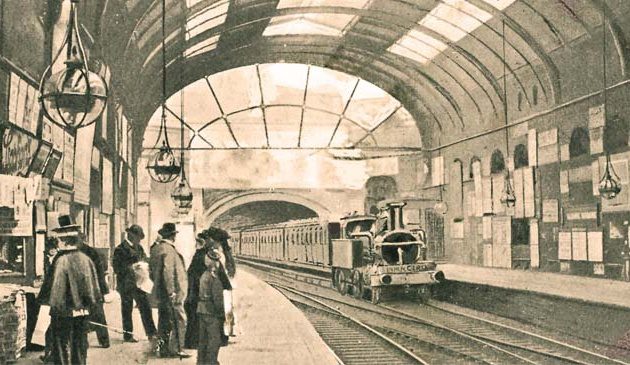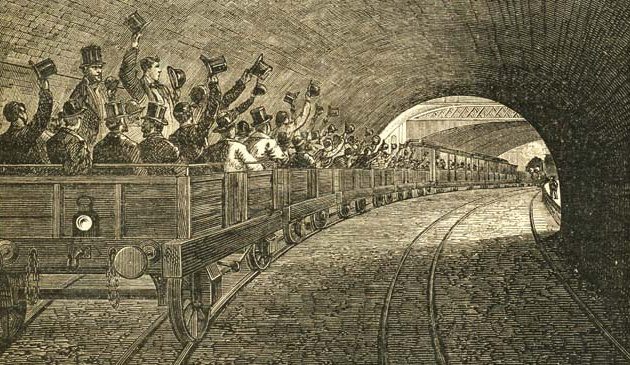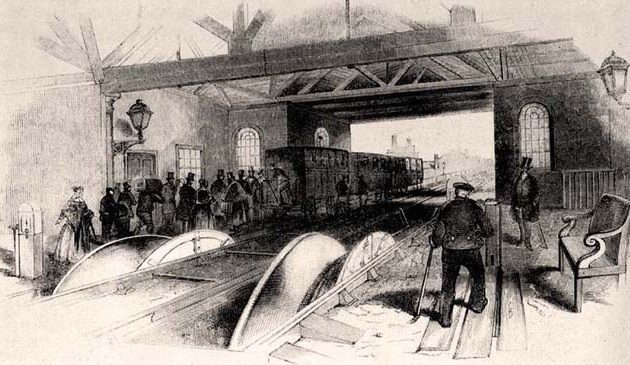Hansom cabs and horse-drawn omnibuses

A cab yard, perhaps somewhere to the east of the City. When business was slow each day, normally in the afternoon or late in the evening, cabbies took their vehicles to one of many yards where washers cleaned and polished the cab and horse-keepers groomed the horse, ready for the next period of work.
It became more important to legislate about Britain’s roads as they were more frequently used by horse-drawn vehicles. Amongst other things, the Highways Act of 1835 formalised that vehicles should pass on the left when approaching other vehicles. With the passing of the Metropolitan Street Act of 1867 omnibuses were obliged to halt on the left-hand side of the street in order to reduce traffic congestion when taking on passengers. Until then buses, like other vehicles, had to pay to pass through turnpike gates, a cost that was passed on to passengers. In 1867 turnpike gates were taken down in Fulham, Kensington, Harrow Road, Haverstock Hill, Camden Road, Holloway Road, Kingsland Road and City Road. Tolls in suburban areas were also reduced.
From the 1860s omnibuses had competition from a gradually expanding network of railways, particularly the Metropolitan and District underground lines within London. The omnibus companies were forced to reduce their fares to compete. With their introduction it became faster to travel longer distances by train. Patterns of travel changed, whereby many travellers tended to take a train for a longer journey and an omnibus for the short distance to reach the nearest station. Thus, omnibuses became a feeder transport for the railway system.
The design of omnibuses changed little until the beginning of the 1880s. It was then that the London Road Car Company introduced a new style. Steps on each side immediately to the rear of the driver took passengers up to the top deck. Behind the steps was a platform onto which passengers could step when entering the lower deck. This was a great improvement for passengers in general, but it required them to enter the bus to the fore of the large rear wheel. Busses had a tendency to roll forward as passengers were boarding or alighting, leading to injuries and deaths. The company soon changed the design, putting the platform and stairs at the rear. At the same time, the standard style of upstairs seating, where passengers sat back-to-back facing outwards, was replaced with garden seats across the deck, with a central passage. This was particularly favoured by women, who had previously tended to avoid upper decks. It did, however, lead to pick-pocketing, with thieves sitting behind their female victim, cutting out her pocket unnoticed. Another innovation was the issuing of tickets to record the fare paid.
The first signs of powered omnibuses appeared in 1897 when an electric bus was tested, and two years later by an oil-driven motor. The London Road Car Company was the first of the major operator to introduce a motor bus, which was initially much smaller than horse-drawn versions, without an upper deck.
A new ring of suburbs was created around the centre of the metropolis as it became possible to speedily commute. The introduction of omnibuses, and steamboats on the Thames, initially had the greatest impact on the managerial classes. Those who could afford it could commute by river from Chelsea or Gravesend. Omnibuses carried managers into the City and to Westminster. Suburbs for the middle classes therefore grew to the north and west of London during the period to the end of the 1830s. It was the later introduction of railways and trams in the middle and second half of the century that allowed the metropolis to expand in all directions and to the south and east.
Sources include: G. A. Sekon ‘Locomotion in Victorian London’; Jerry White ‘London in the 19th Century’; Liza Picard ‘Victorian London’; Mike Paterson ‘The Gondola of the Strand’, London Historians’ Blog; John Richardson ‘The Annals of London’; ‘Living London’ ed. George R. Sims (1903); Henry Charles Moore ‘Omnibuses and Cabs’ (1902); Adrienne E. Gavin, Andrew F. Humphries ‘Transport in British Fiction’; Christian Wolmar ‘The Subterranean Railway’; Christian Wolmar ‘Cathedrals of Steam’; Robin Rowles ‘The Civil War in London’.


